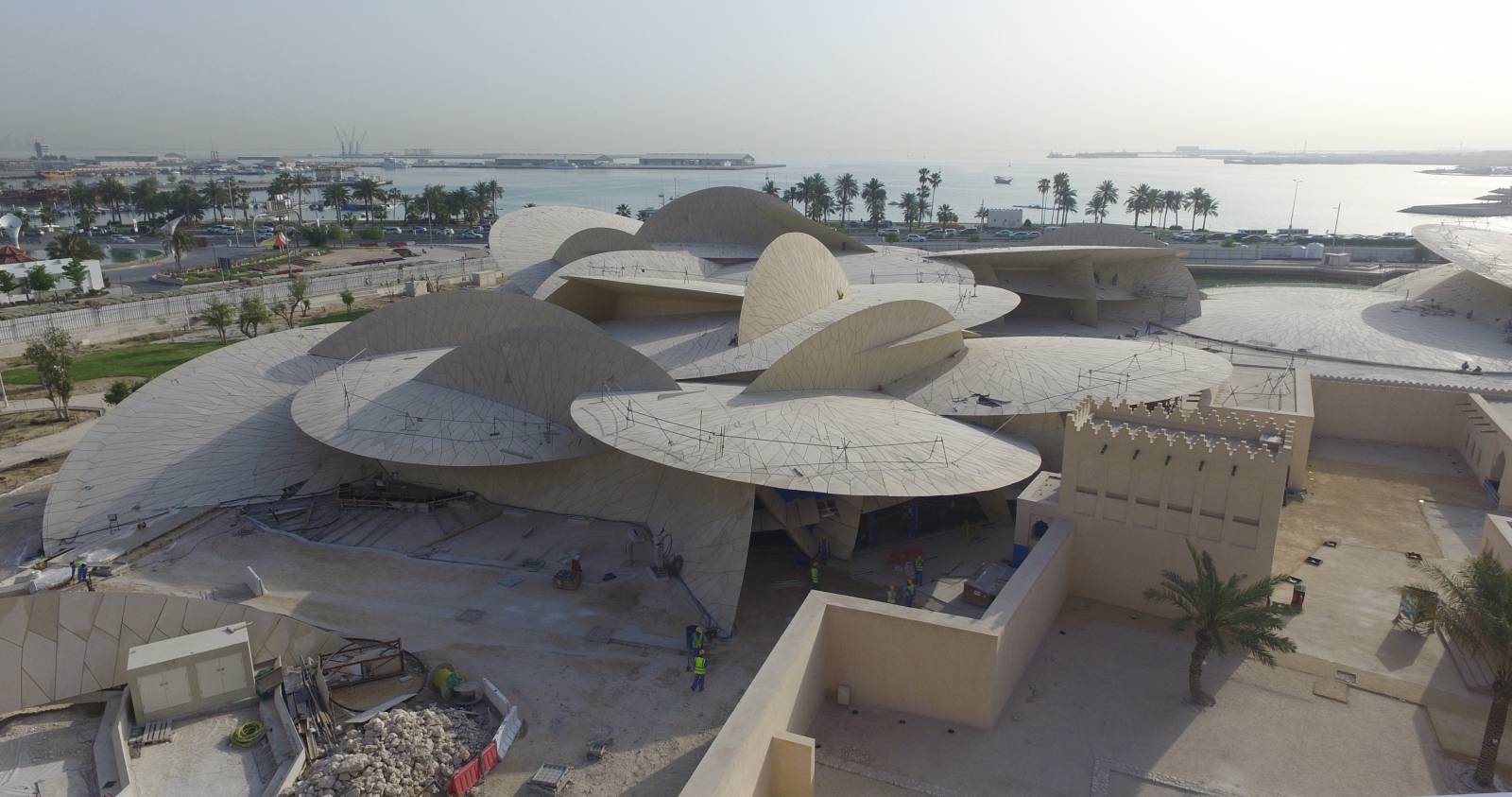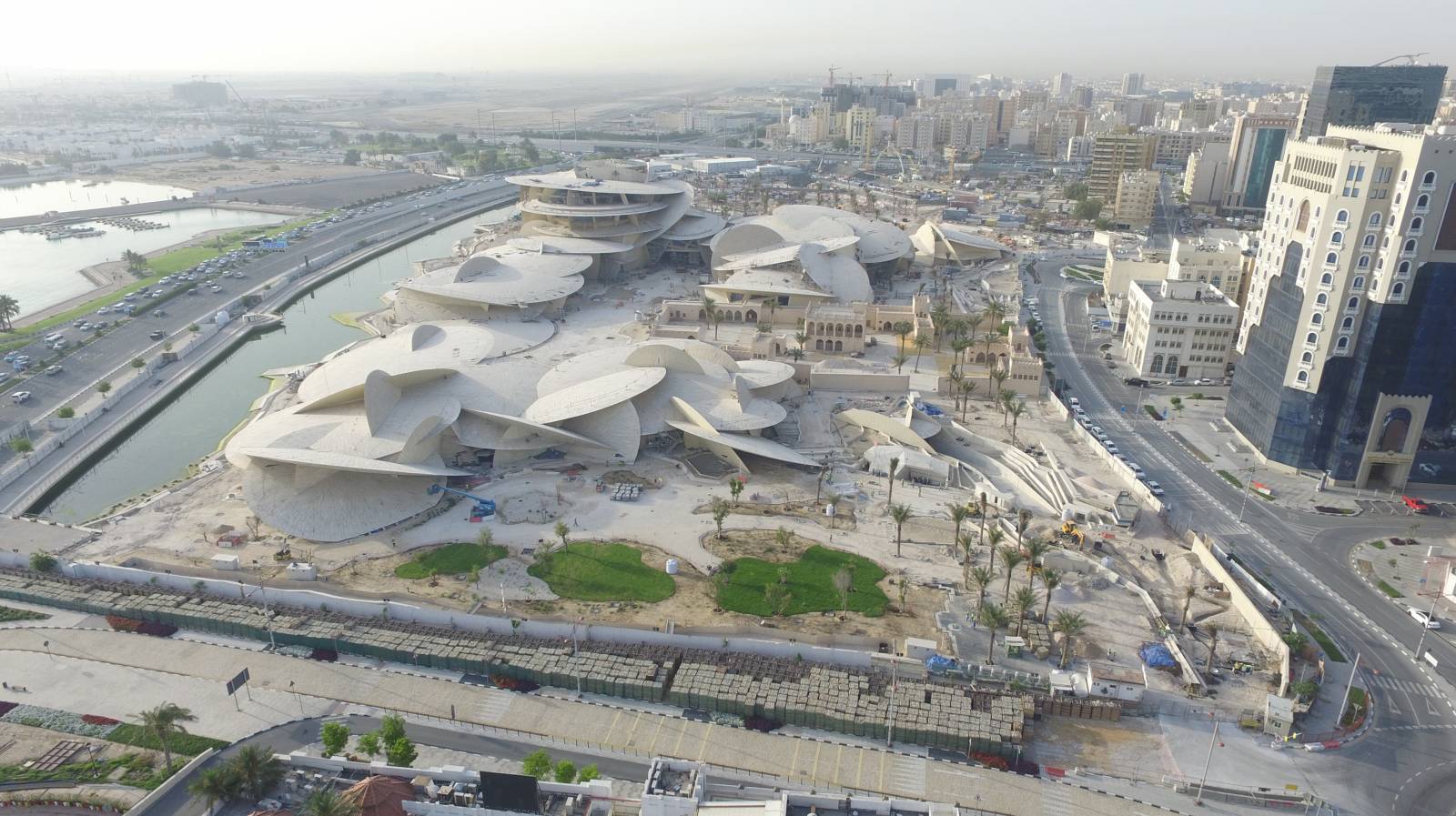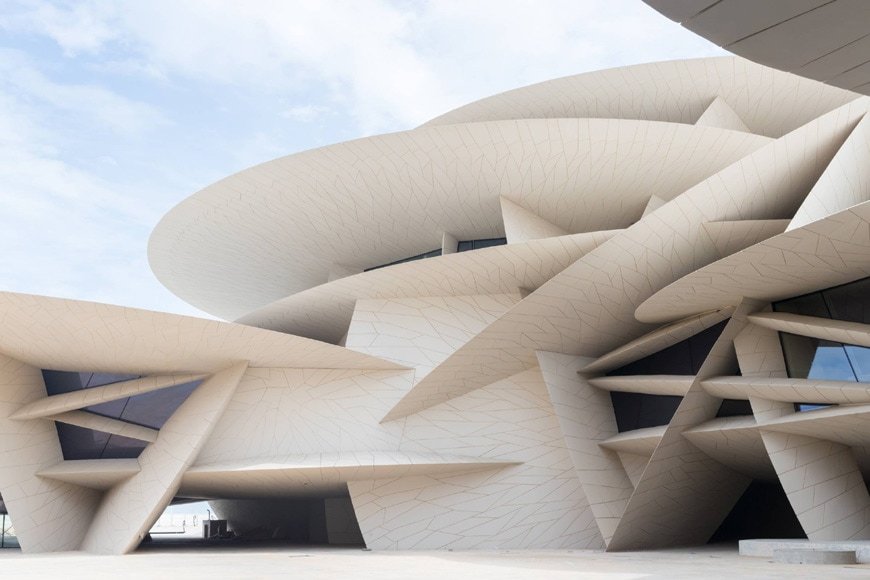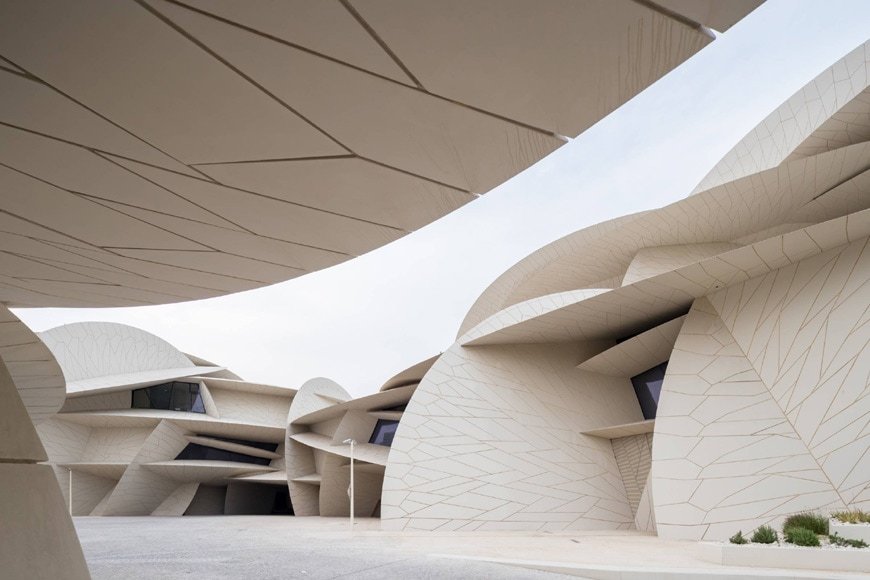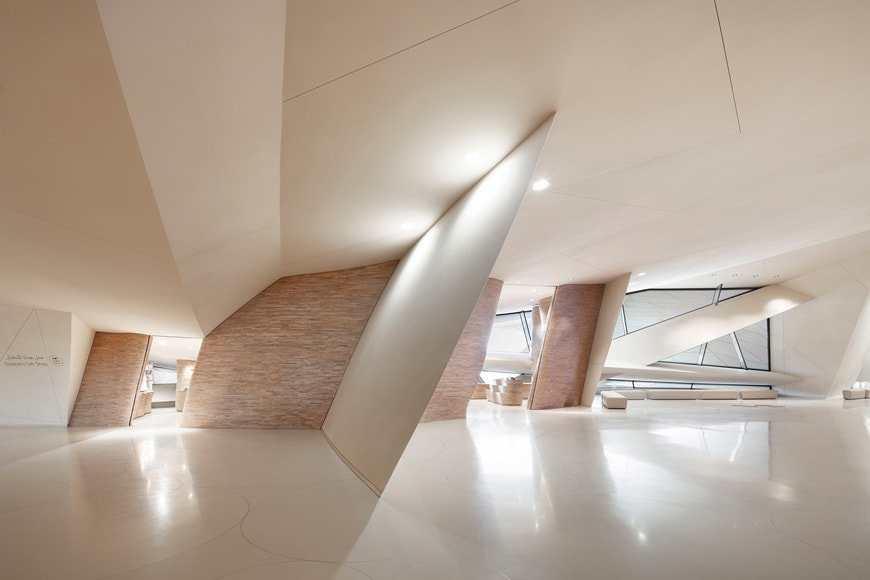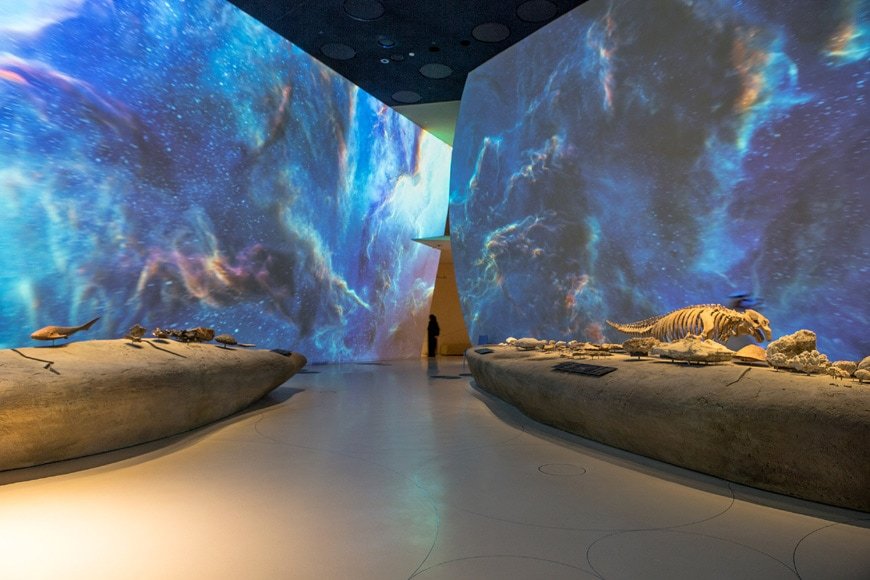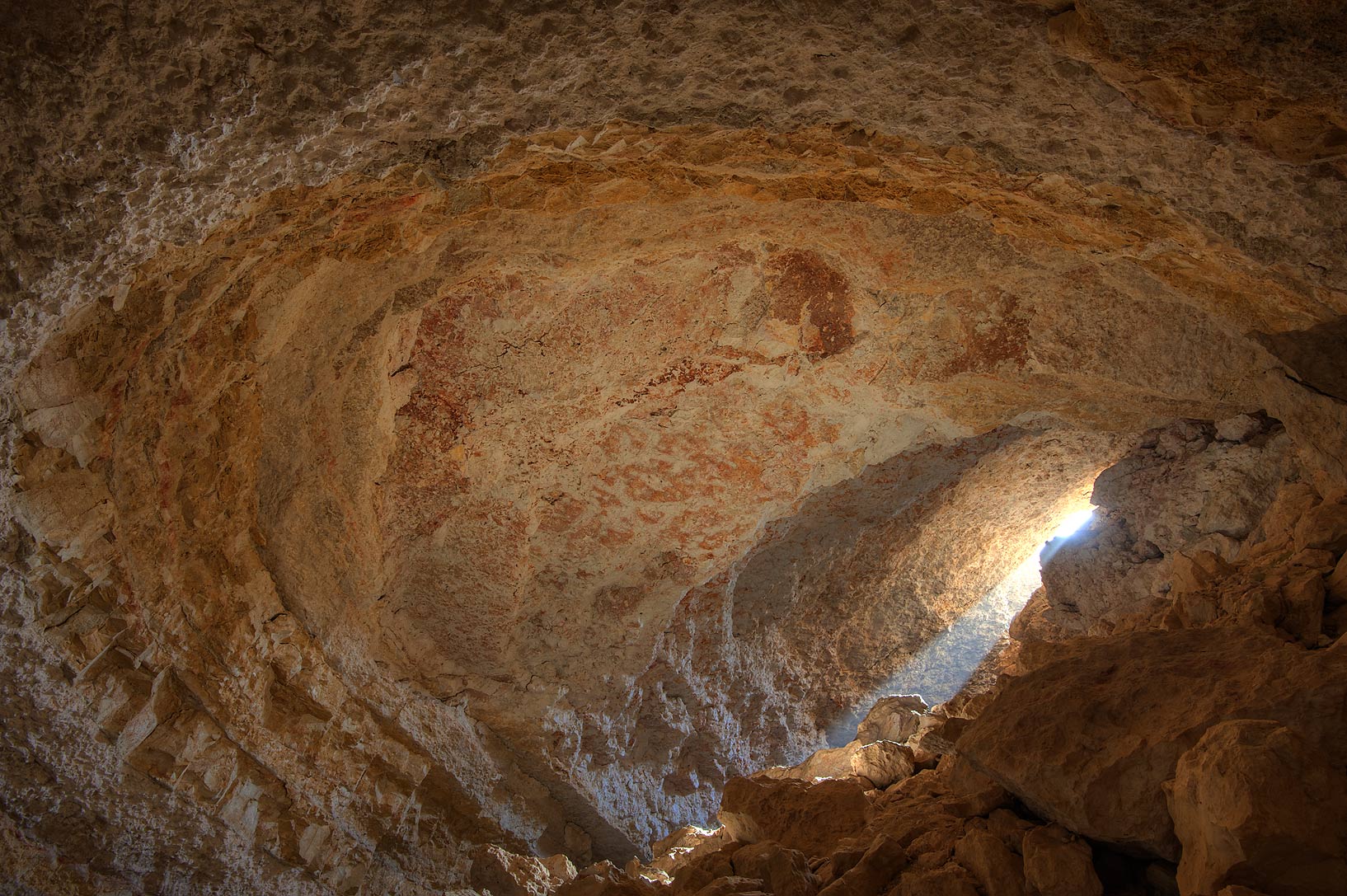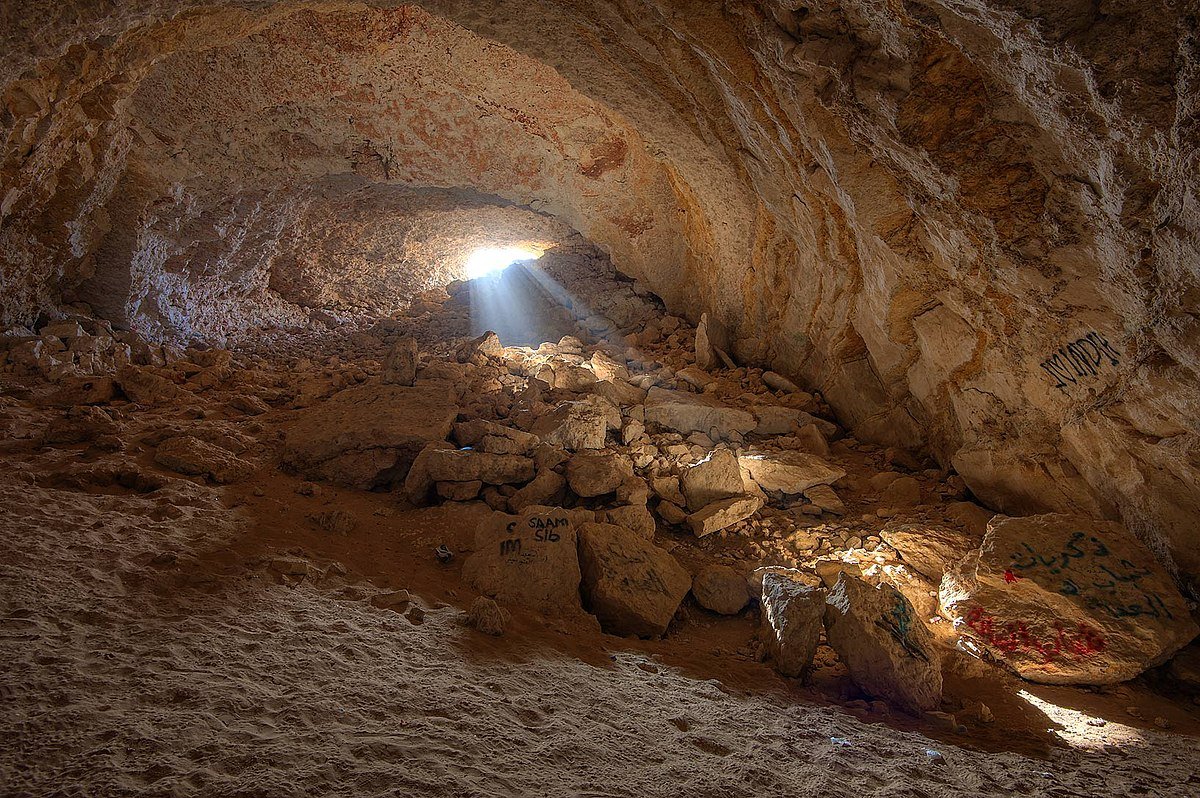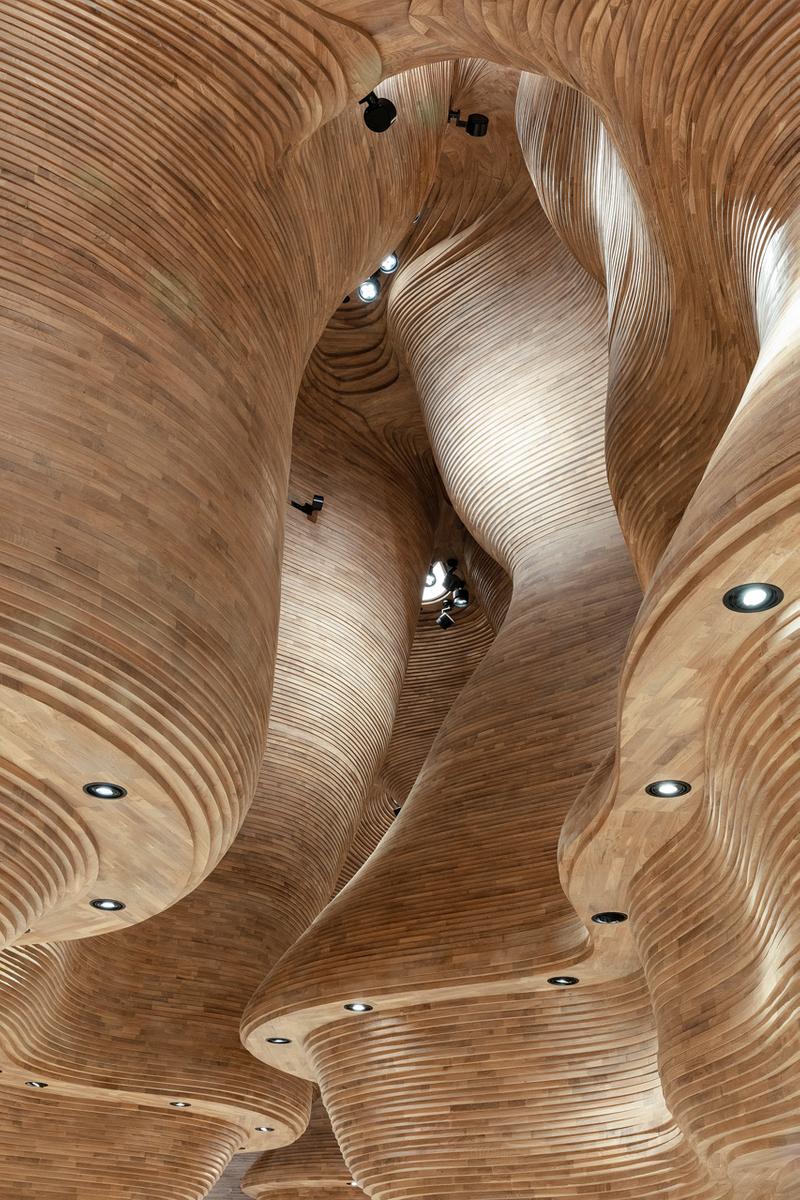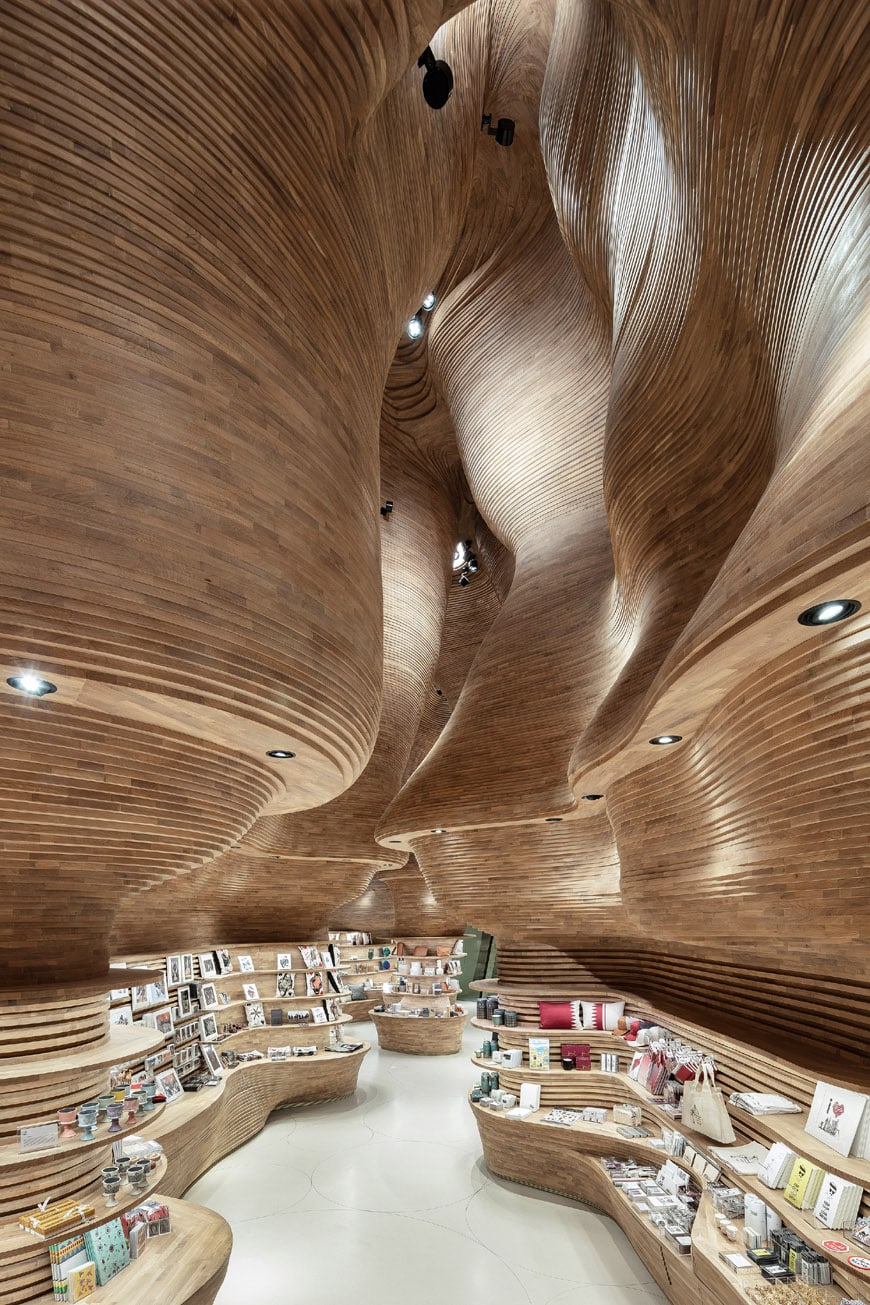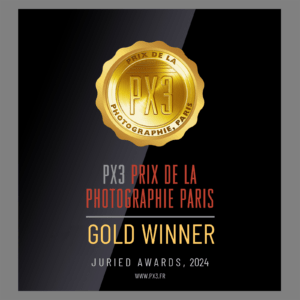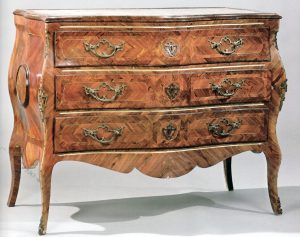LA ROSA DI DOHA, la visione di Jean Nouvel -THE ROSE OF DOHA, Jean Nouvel’s vision
Una rosa particolare, un omaggio alla cultura araba è il visionario progetto del nuovo Museo Nazionale del Qatar (QNM) a Doha concepito da Jean Nouvel, l’architetto francese premio Pritzker 2008, dopo le sue esperienze passate nella progettazione dell’Institut du Monde Arabe (1987) di Parigi e del Louvre di Abu Dhabi (2017).
Inaugurato nel 2019, il Museo Nazionale del Qatar (QNM) stupisce ed emoziona per la sua ampiezza e per le sue forme. Su una superficie di oltre 46.000 mq. la costruzione ha una forma ad anello composto dall’intersezione di padiglioni che circondano un ampio cortile e il palazzo reale, da poco restaurato, dello sceicco Abdullah bin Jassim Al Thani. Tutta la struttura rimanda all’idea di un caravanserraglio, il tradizionale luogo chiuso usato per la sosta delle carovane che attraversavano il deserto.
A unique rose, a tribute to Arab culture, is the visionary project of the new National Museum of Qatar (NMoQ) in Doha, conceived by Jean Nouvel, the French architect and recipient of the 2008 Pritzker Prize. This comes after his previous experiences in designing the Institut du Monde Arabe (1987) in Paris and the Louvre Abu Dhabi (2017).
Inaugurated in 2019, the National Museum of Qatar (NMoQ) astonishes and captivates with its vastness and its forms. Spanning over 46,000 square meters, the structure takes the shape of a ring composed of intersecting pavilions surrounding a large courtyard and the recently restored royal palace of Sheikh Abdullah bin Jassim Al Thani. The entire structure evokes the idea of a caravanserai, the traditional enclosed space used for caravans to rest during their desert journeys
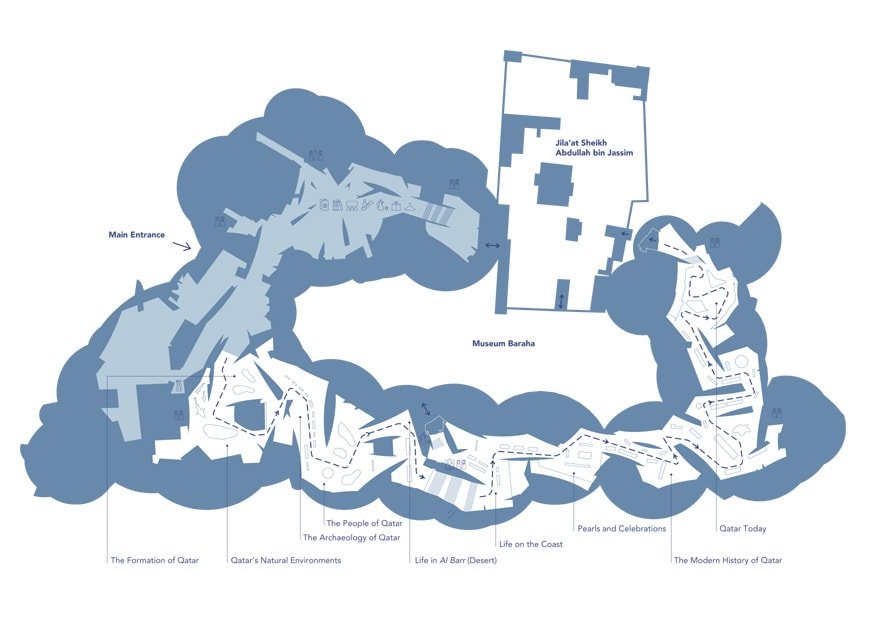
Planimetria Museo Nazionale del Qatar (QNM) - Doha - ©Arch. Jean Nouvel
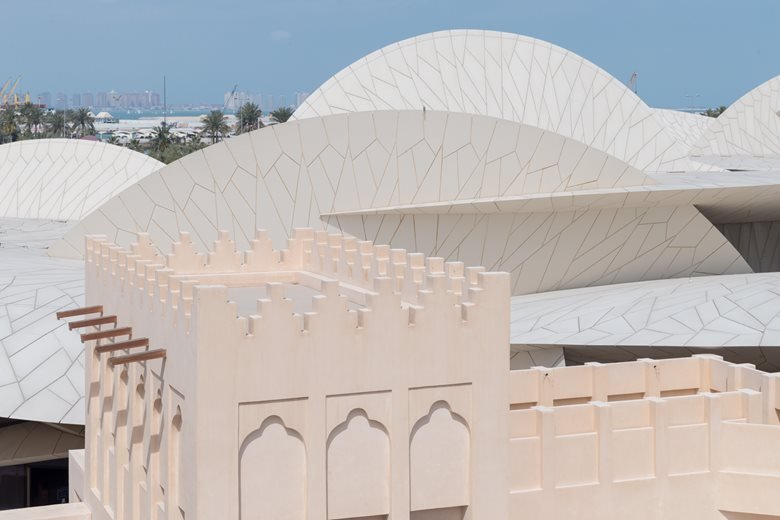
Museo Nazionale del Qatar (QNM) e il Palazzo Reale dello Sceicco Abdullah bin Jassim Al Thani ©foto Iwan Baan- Doha -
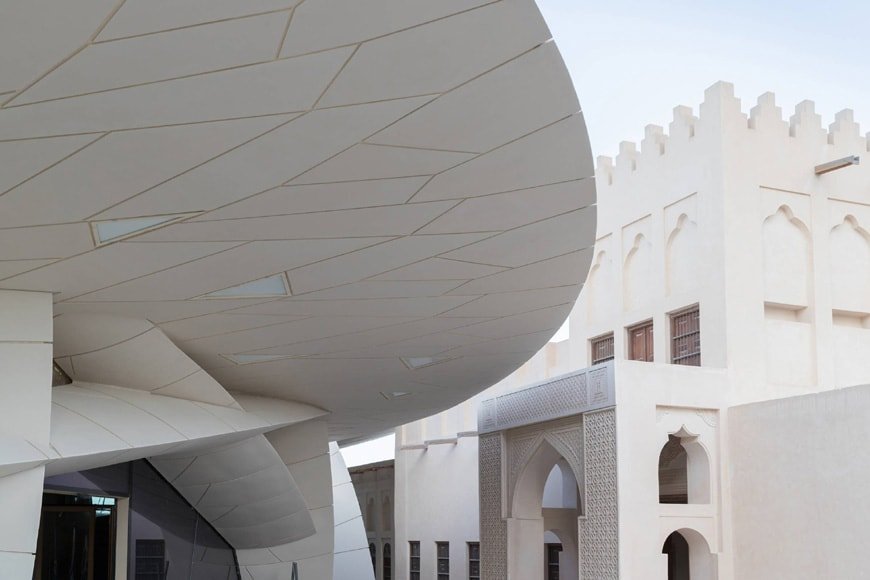
Museo Nazionale del Qatar (QNM) e il Palazzo Reale dello Sceicco Abdullah bin Jassim Al Thani ©foto Iwan Baan- Doha -
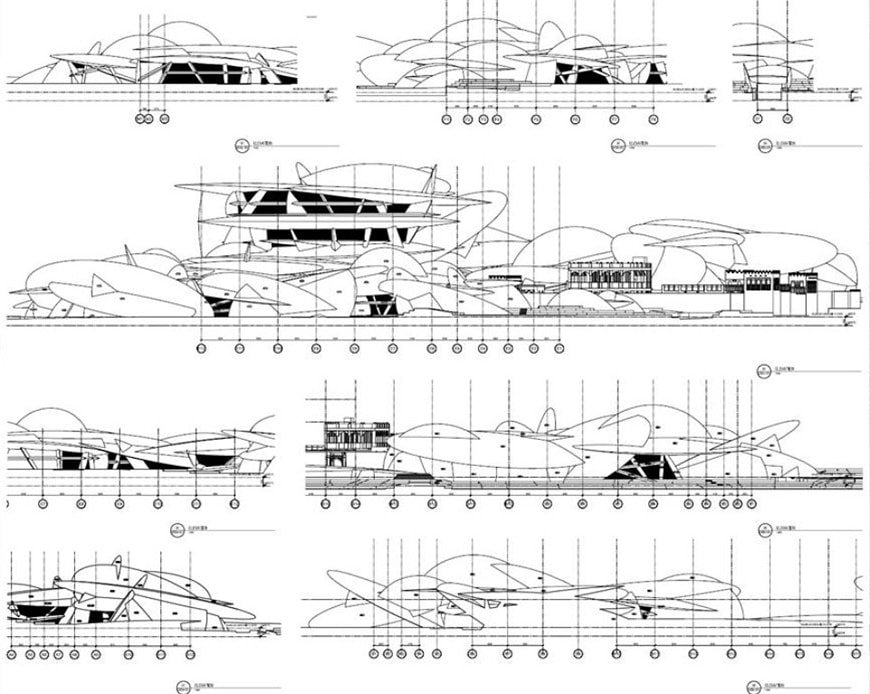
Progetto Museo Nazionale del Qatar (QNM) - Doha - Arch. Jean Nouvel ©Jean Nouvel architects
Dietro la nascita di questo nuovo progetto c’è la mano della sorella dell’emiro, la sceicca Mayassa al Thani, la mecenate che presiede il consiglio di amministrazione del Qatar Museums Authority.
Tra gli obiettivi che hanno portato alla realizzazione dell’edificio c’era l’esigenza di voler celebrare l’archeologia, la storia naturale, le tradizioni e la cultura del Qatar, a partire da milioni di anni fa fino ad arrivare alla sua storia meno recente. Il museo è organizzato infatti per documentare con manufatti geologici e archeologici i tre periodi della storia del paese: l’inizio, la vita in Qatar e la costruzione del Paese. All’interno del museo è esposto un tappeto unico al mondo, di manifattura indiana, realizzato e commissionato un secolo e mezzo fa per la tomba di Maometto a Medina.
Il tappeto, ordinato dall’allora Maharaja di Baroda, nel Gujarat indiano, è ricamato con oltre 2 milioni di perle oltre a smeraldi, diamanti e zaffiri.
Behind the birth of this new project lies the hand of the Emir’s sister, Sheikha Mayassa al Thani, the patron who chairs the board of Qatar Museums Authority.
Among the goals that led to the realization of the building was the desire to celebrate archaeology, natural history, traditions, and culture of Qatar, starting from millions of years ago to its more recent history. The museum is organized to document, with geological and archaeological artifacts, the three periods of the country’s history: the beginnings, life in Qatar, and the construction of the country. Inside the museum, there is a unique carpet in the world, made in India, commissioned a century and a half ago for the tomb of Mohammed in Medina.
The carpet, ordered by the then Maharaja of Baroda, in the Indian state of Gujarat, is embroidered with over 2 million pearls in addition to emeralds, diamonds, and sapphires.

L’idea architettonica alla base del nuovo Museo Nazionale del Qatar è straordinariamente semplice: quella di una rosa del deserto, un minerale spesso presente nelle aree desertiche dovuto ad un agglomerazione di cristalli di gesso che si aggregano in lamine naturali e tondeggianti, più sottili alle estremità. Queste lamine si intrecciano e si compongono come i petali di un fiore.
Il luogo su cui sorge l’edificio è quindi all’origine di un sistema organico realizzato tramite dischi ad incastro, dalle tonalità color sabbia, che caratterizzano l’imponente architettura.

La costruzione, di estrema complessità formale, ha una struttura metallica rivestita in calcestruzzo fibro-rinforzato in modo da creare forme libere ed è costituita da una serie di dischi orientati in tutte le direzioni. I dischi sono di differenti ampiezze e le relative sporgenze garantiscono l’ombreggiatura necessaria. Ogni disco è costituito da una struttura metallica rivestita da pannelli in calcestruzzo separati ogni quattro metri da dei giunti di dilatazione che, esaltando le linee di fuga creano sulla superficie un disegno articolato.
Lo sfalsamento dei dischi variamente orientati forma delle aperture riempite da facciate vetrate.
The construction, of extreme formal complexity, features a steel structure coated in fiber-reinforced concrete to create free forms and consists of a series of discs oriented in all directions. The discs vary in size, and their protrusions provide necessary shading. Each disc comprises a steel structure covered with concrete panels separated every four meters by expansion joints which, emphasizing the vanishing lines, create an articulated pattern on the surface.
The staggered arrangement of the discs, oriented in various directions, forms openings filled with glass facades.

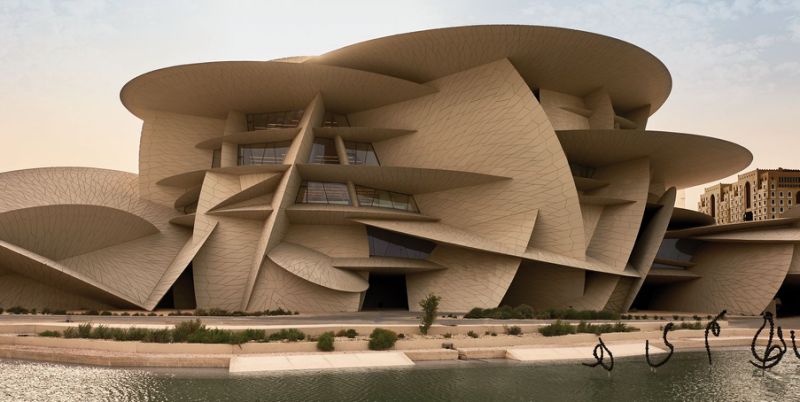
All’interno nulla è lineare, le undici gallerie che formano l’intero anello espositivo hanno pareti che si incurvano verso l’interno e verso l’esterno, in grado di trasformarsi in schermi cinematografici lasciando il visitatore libero di vagabondare con l’illuminazione puntiforme che, proiettata sul pavimento, crea un suggestivo disegno grafico.
Inside, nothing is linear. The eleven galleries forming the entire exhibition ring have walls that curve inward and outward, capable of transforming into movie screens, leaving the visitor free to wander amidst the pinpoint lighting projected onto the floor, creating a suggestive graphic design.
Altro elemento di rilievo, stupefacente nella realizzazione, è la parte che contiene i negozi, il cui interno, progettato dallo studio d’architettura Koichi Takada Architects, è interamente in legno lamellare dalle forme sinuose in modo da creare la suggestione visiva di un canyon scavato nella roccia in completa armonia con la visione di Jean Nouvel.
La struttura in legno dovrebbe riflettere lo stesso bellissimo santuario sotterraneo di Dahl Al Misfir, la “Grotta della Luce” del Qatar, che forma cristalli simili alla luna.
Another remarkable feature, astonishing in its execution, is the section housing the shops, whose interior, designed by the architectural firm Koichi Takada Architects, is entirely made of laminated wood with sinuous forms, creating the visual suggestion of a canyon carved into the rock in complete harmony with Jean Nouvel’s vision.
The wooden structure is meant to reflect the same beautiful underground sanctuary of Dahl Al Misfir, the “Cave of Light” in Qatar, which forms moon-like crystals.
Oltre agli spazi espositivi il complesso museale ospita anche un auditorium da 213 posti, spazi per la didattica, un centro di ricerca, negozi e caffetterie, un ristorante panoramico e un parco con un giardino botanico, un giardino di sculture, una laguna artificiale, un campo da gioco per bambini e vari servizi per i visitatori.
Tutto in questo museo è stato concepito in modo che il visitatore possa avvertire il deserto e il mare, cioè i due elementi da cui nasce la storia di questa giovane nazione formata da pastori nomadi e da pescatori di perle, in uno dei pochi luoghi del pianeta dove, appunto, il deserto raggiunge il mare.
In addition to exhibition spaces, the museum complex also houses a 213-seat auditorium, educational spaces, a research center, shops, cafes, a panoramic restaurant, and a park featuring a botanical garden, a sculpture garden, an artificial lagoon, a playground for children, and various visitor services.
Every aspect of this museum has been designed so that visitors can experience the desert and the sea, the two elements from which the history of this young nation, formed by nomadic herders and pearl divers, originates. It is situated in one of the few places on the planet where the desert meets the sea.
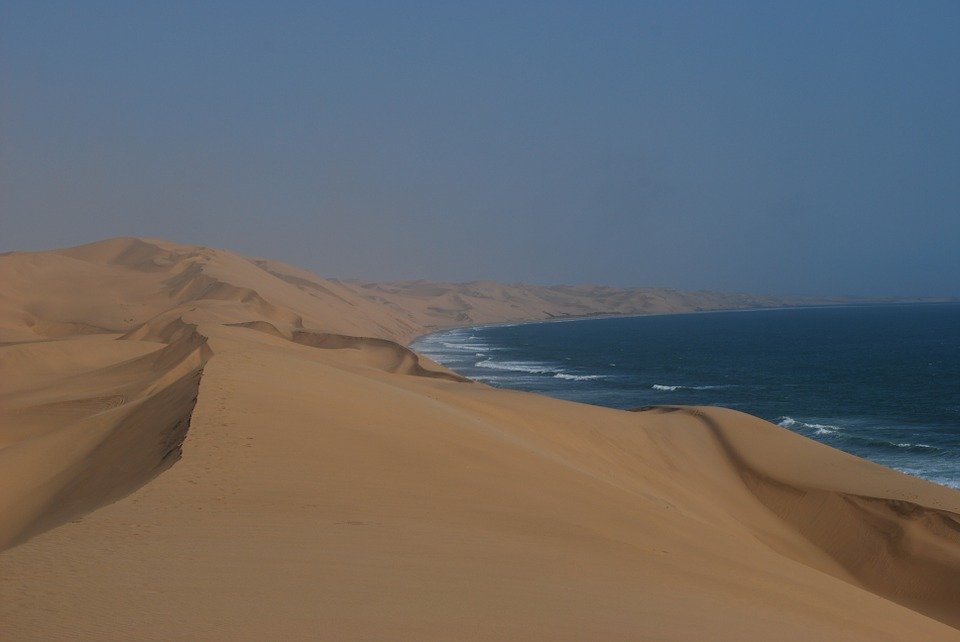
Per saperne di più:
per approfondimenti sul Museo di Arte Islamica a Doha, architetto Pei:
©Giusy Baffi 2020
© Le foto sono state reperite da libri e cataloghi d’asta o in rete e possono essere soggette a copyright. L’uso delle immagini e dei video sono esclusivamente a scopo esplicativo. L’intento di questo blog è solo didattico e informativo. Qualora la pubblicazione delle immagini violasse eventuali diritti d’autore si prega di volerlo comunicare via email a info@giusybaffi.com e saranno prontamente rimosse oppure citato il copyright ©.
© Il presente sito https://www.giusybaffi.com/ non è a scopo di lucro e qualsiasi sfruttamento, riproduzione, duplicazione, copiatura o distribuzione dei Contenuti del Sito per fini commerciali è vietata.
© The photos have been sourced from books, auction catalogs, or online and may be subject to copyright. The use of images and videos is solely for explanatory purposes. The intent of this blog is purely educational and informational. If the publication of images were to violate any copyright, please communicate this via email to info@giusybaffi.com, and they will be promptly removed or the copyright © will be cited.
© The present website https://www.giusybaffi.com/ is not for profit, and any exploitation, reproduction, duplication, copying, or distribution of the Site’s Content for commercial purposes is prohibited.
